When my family visited London a few years ago, after touring the Greenwich area on a freezing cold Sunday in March, before heading back to the train station, we decided to stop somewhere to have a bite to eat, in the hope that we would feel warmer. I've never appreciated a hot meal as much as during that first trip to my favorite holiday destination in the world; it rained very little during our ten-day stay, but the temperatures were lower than 5 degrees Celsius most of the time. We found a diner on the main high street in the area with the word 'kebab' written on the sign. Finally, I thought, I'm getting a chance to eat at a Turkish restaurant. We all ordered kebabs, and came out of the restaurant at the end of the meal wondering if there was any essential difference between 'kebab' and 'souvlaki'.
Both 'souvlaki' and 'kebab' have the same modern Greek meaning: 'skewered meat'. The original meaning of the word 'kebab' is 'fried meat'; this meaning is retained in stew-like meals such as 'bowl kebab', but not in the Greek sense. The word 'souvlaki' means 'little souvla'; the big souvla is where Greek-style lamb is cooked at Easter, over a hot fire on a spit. Kebab is most likely Arabic in origin, and is used in the Turkish language for the same kind of food that we call souvlaki in Greece. Both words are used in Greece, but each one denotes something different. So it's really important to know what to ask for when ordering at a taverna, as Matt Barrett points out; his Tale of 2 Souvlakia makes an interesting point about using the right phraseology so that you can take back happy food memories from a Greek holiday.
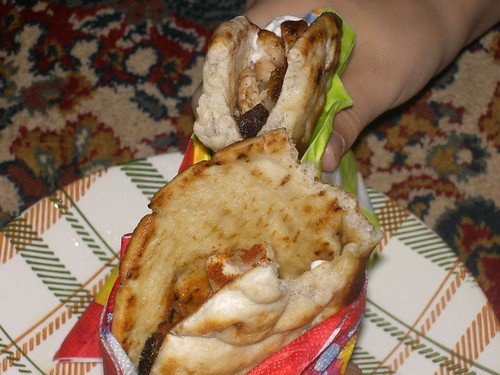
When ordering souvlaki pita/yiro, you can ask to omit one of the garnishes, eg onions. When I make souvlaki at home using leftover BBQ meat, my kids prefer them without tomatoes and onions. Shame really, but hopefully, they'll learn to eat them as they were meant to be eaten once they get older.
When Greeks ask for a 'souvlaki' from a takeaway bar, they usually mean pita bread wrapped round slivers of roast pork meat (you can also ask for chicken instead) that have been sliced off an upright rotating grill, topped with slices of onions and tomatoes and some yoghurt, and sprinkled with red pepper (paprika), and maybe a few fried potatoes added to it as well. But the same word can also mean cubed pork meat on skewers, cooked BBQ style, which is often served on a plate, although it can also be served wrapped round pita bread (skewer removed) with all the regular toppings. When buying freshly prepared skewered meat from a butcher, Greeks will ask for souvlaki; it's highly unlikely that they were expecting a cooked meal from a place like this!
This is really confusing for some people who expect to be served the sandwich style souvlaki at a taverna, but get the skewered souvlaki on a plate. Because of that politically correct tendency that English language speakers and Northern Europeans carry with them when they travel, to accept what they are given without question, most tourists simply thank the waiter and try to hide their dismayed looks, but inevitably, they go away thinking that Greece isn't all it's cracked up to be.

Souvlaki served to children at a day camp site; freshly prepared souvlaki is available from any Greek butcher's shop on a daily basis.
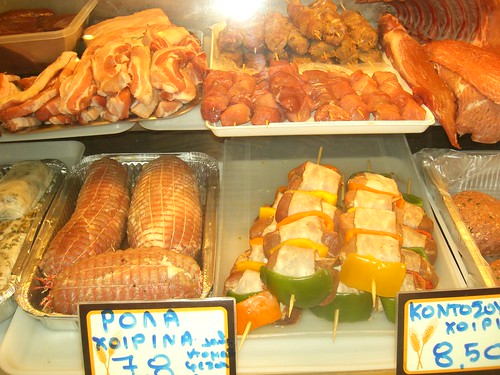
If you want a souvlaki wrapped in pita bread with greaseproof paper, you should ask for a 'pita yiro'; yiro' means 'round', so the souvlaki will be wrapped in pita bread and held with the hands. These are to the Greeks what the hamburger is to the American, or fish and chips to the British. Many takeaway places also serve them on a plate at the table, not just as take-out meals. If you really do want the skewered meat, then say 'xilaki' or 'kalamaki', which both mean 'little stick', meaning that the souvlakia will be cubed meat (still on the skewers), served on a plate; the normal serving size is two 'xilakia/kalamakia' per person. If the taverna is more up-market, a metal skewer is used instead, and you'll probably get one large souvlaki.
Souvlakia in Greece are hardly ever referred to as kebabs. The Greek 'kebab' (a word adopted into the Greek culture from the time of the occupation of the Ottomans) has come to denote compacted minced meat with herbs and spices added, wrapped round a skewer and cooked over an open fire, just like the souvlakia on sticks. So if you ask for a 'kebab', don't be surprised if the meat on the skewer looks like one long sausage without its casing; that's what you asked for. If you ask for a 'pita kebab', then that sausage will come inside some pita bread (minus the skewer) with all the trimmings, just like the 'yiro' described above.
*** *** ***
For a truly Athenian food experience, you mustn't miss out on al fresco dining, under one of the most famous monuments in the world, at one of the kebab houses located in Monastiraki, in the centre of Athens. If you've been through Athens without doing this, then you've probably missed out on the greatest traditional culinary experience that this city has to offer.
Bairaktaris, Thanasis and Savvas all serve really good juicy kebabs that very few cooks can imitate in their own homes. The secret is in the large quantities they make and their own special blends of herbs and spices that they have developed over the decades. Some kebab shops serve mainly (or only) kebabs, so that their product is always fresh, given the large turnover of the same product. I've been to all three of the kebab restaurants mentioned above, and I found the food served at all of them equally good. Savvas seemed to have the most friendly staff and there was no hawking for customers (at least on the day I was there).
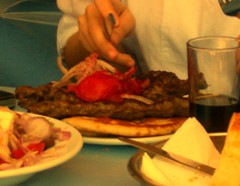
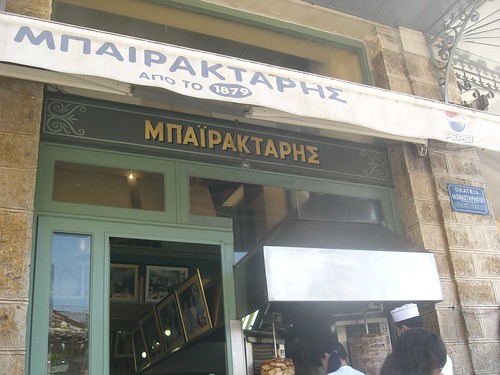
These kebab houses on Monastiraki Square are located in the same area and have a very respectable reputation; they are always crowded with diners eating delicious succulent kebabs served on pita bread with onions and tomato. Salad, fried potatoes and tzatziki are always served on the side ,and some of these places serve little else.
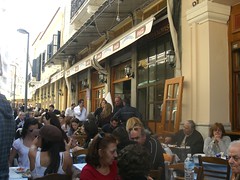
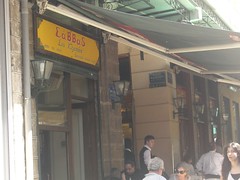 .
.To make kebabs of the highest order, you need a good recipe, the right cooking facilities and possibly some good cooking skills learnt from experience. Making kebabs is a little like making biftekia; you can use a basic meatball recipe, but the kebab mixture must be super smooth and sticky, so that it will stay put when you stick a skewer into its centre. Make sure all the ingredients are so finely cut or ground that when they are rolled into a ball, they will look like one big reddish brown mass.
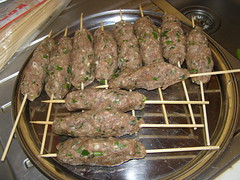
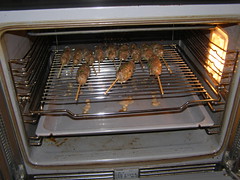
I'm still perfecting my kebab recipe in terms of spice combinations. A perfect kebab needs to be smoother in appearance than mine, it should be cooked over an open fire, and it should retain its juices.
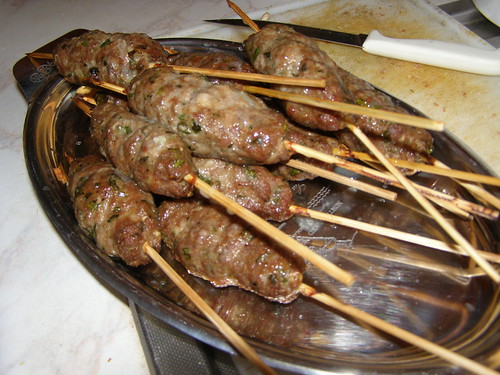
Lamb mince is unusual to work with in Greece, since not many butchers will mince lamb for you (and this is the preferred meat, along with beef, that is used in Turkish kebabs, due to religious practices). I found some lamb mince recently at AB Vasilopoulos, although it was imported from France and mixed together with beef mince. I added some onion, garlic, herbs and spices, shaped them into rissoles, skewered them and grilled them in a hot oven, turning on all sides to get them as browned as possible. We had them with a fantastic tzatziki and a Greek salad; it made an excellent meal during a heatwave in early June this year, with Joy and Bryan for company, who accepted my blog intro's invitation: "If you're ever in Hania, come and join us for lunch...".
©All Rights Reserved/Organically cooked. No part of this blog may be reproduced and/or copied by any means without prior consent from Maria Verivaki.

Souvlaki is pretty much my favourite on-the-go food. Absolutely love it, and miss it when Im away for a while
ReplyDeleteAwww, this post brings back memories...We used to hang around Savvas' place when i was a student in Athens.
ReplyDeleteWe were actually trying to have a bite in amongst gently denying offers for CDs, DVDs, cigarette lighters, watches, leather belts, live music or whatever else was on offer from different wandering sellers. A whole different experience than sitting down to eat even in Covent Garden market.
There are times in every place that are magical. We were sitting at Savvas' once and the Sun was setting and the crowd had receded in preparation for the night life. There was a gentle breeze and you could swear you were eating in some laid back village and not the city....magic!
I nice run down of the different meats and what Greeks grill. For the Kebabs, form them and then place them in the fridge for an hour or so to set (this helped).
ReplyDeleteYours look fab, surely better the next time you strike-up the charcoals and again, efharisto poli for the link-love!
I would have no problem enjoying them all:D
ReplyDeleteΤο φαγητό που λείπει πιο πολύ απ όλα στην μεγάλη μου κόρη που ζει στο Λονδίνο είναι το σουβλάκι! Αρνείται να φάει εκεί (εκτός αν το φτιάξει η ίδια στο σπίτι της) και είναι το πρώτο που ζητάει μόλις έρθει εδώ.. αλλά κι εγώ το λατρεύω και το δικό σου φαίνεται θαύμα - μου άνοιξες την όρεξη!!!
ReplyDeleteThe secret to a good minced kebab on a stick is to work the meat. Take your fresh mince (any kind of meat will do - we make beef ones all the time), mix in your spices, and even a touch of liquid if you like (try a bit of beer).
ReplyDeleteThen knead the meat like you would bread dough. This allows the proteins to bind to the liquid and the meat goes tacky. Once it is sticky like that, it will easily stick to the kebab stick and stay formed.
great addition of beer - i'll try this next time
ReplyDeleteI agree with Val...I love em all! My preference is for lamb meat as we do here in Oz.
ReplyDeleteKebad on charcoal has different taste believe me!
ReplyDeleteI am glad you liked Savvas Maria!
ReplyDeleteI forgot to add - the most important ingredient in minced meat kebab is salt - it helps the proteins bind together once you start kneading the meat.
ReplyDeleteYou must mix the salt in, rather than sprinkle it out the outside.
This was so informative! There's so much lost in translation, and now I know what is what! Of course, I'd be happy to eat whatever was brought to me and be none the wiser! :-)
ReplyDeleteWe were in Hania 2 Octobers ago. I wish I had known about you then. We took a walking tour for a week- which, of course, included Samaria Gorge; and then we drove around the island for another week. I have hundreds of pictures of goats, because I believe they are among the most charming creatures alive; and each one was more alluring than the last.
ReplyDeleteI found your website while looking for Greek recipes, and I have been a visitor ever since.
We live in Utah; we are not Mormon, and we have also been hiking in NZ -South Island. Someday I want to see North Island. Our daughter hinked there for a week after finishing up a job in Australia, and she was charmed.
Visiting in Slat Lake City? Just let us know.
what is the difference between kabab and kaftidis?
ReplyDeletekeftedes (not kaftidis!) are fried balls of minced meat (meatballs) - they are made with a similar mixture to the kebabs
ReplyDeleteThank you for this tutorial on kebabs and souvlakia! I didn't really think about their differences, relying instead on the descriptions on the menu. it's infinitely better to be aware not only for their distinctions in form but also of history.
ReplyDelete